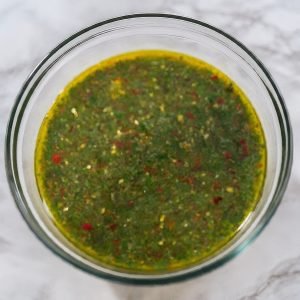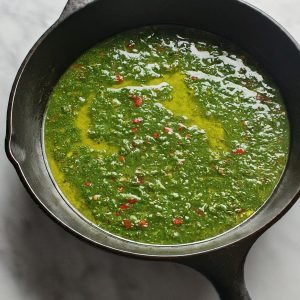
If you’re looking to take your pizza game to the next level, chimichurri pizza sauce is what you need. This fresh, zesty, and herb-packed sauce adds a vibrant twist to the usual tomato-based varieties, making your pizza pop with flavor. Whether you’re a pizza enthusiast or someone curious about trying something different, this recipe will guide you to making the best chimichurri pizza sauce, packed with flavor and perfect for any pizza night.
Why Chimichurri for Pizza Sauce?
Chimichurri sauce isn’t just for steak or grilled veggies; it brings a bold, herby punch that elevates your pizza. Traditional tomato sauce is great, but chimichurri takes things up a notch with its mix of parsley, garlic, vinegar, and olive oil. The brightness of the herbs paired with the tangy vinegar creates an irresistible flavor combination that complements pizza toppings beautifully, whether you’re going for classic mozzarella or something more adventurous like grilled vegetables or spicy sausage.
Chimichurri is an Argentine herb sauce traditionally used for grilled meats, but its versatility makes it a perfect fit for pizza. It’s bold, fresh, and cuts through rich toppings with its herbaceous and tangy bite. This sauce brings life to every slice, offering a flavor profile that’s different from the sweet, acidic notes of tomato sauce.
So why should you make the switch to chimichurri?
- Freshness: With ingredients like parsley, garlic, and olive oil, this sauce is bursting with freshness that balances out heavier toppings like cheese and meats.
- Boldness: Chimichurri packs a punch with its robust flavor, adding depth and character to your pizza.
- Versatility: Use it as a base or drizzle it over your pizza after baking for an added layer of flavor. Either way, it’s a game-changer.
The Ultimate Chimichurri Pizza Sauce Recipe
This is your go-to recipe for a classic chimichurri sauce that’s perfect for pizza. It’s quick, easy, and full of flavor.
Ingredients:
- 1 cup fresh parsley (finely chopped)
- 4 cloves garlic (minced)
- 2 tbsp red wine vinegar
- 1/2 cup extra virgin olive oil
- 1 tsp dried oregano
- 1/2 tsp red pepper flakes (optional for a spicy kick)
- Salt and pepper to taste
Instructions:
- Prep the herbs: Finely chop the fresh parsley and mince the garlic for a fresh, aromatic base.
- Mix the base: In a bowl, combine the parsley, garlic, red wine vinegar, oregano, and red pepper flakes. Stir well to distribute the flavors evenly.
- Add olive oil: Slowly pour in the olive oil while stirring to emulsify the sauce. This is what makes chimichurri rich and smooth.
- Season and adjust: Taste the sauce and adjust with salt, pepper, or more vinegar based on your preference.
This vibrant sauce is now ready to be the star of your next pizza creation!




How to Use Chimichurri Pizza Sauce:
There are a few ways you can use chimichurri sauce on your pizza, depending on how bold you want the flavor to be. It’s a versatile sauce that can be used either as the base sauce or as a finishing drizzle to enhance your pizza.
As a Base Sauce:
Instead of the typical sauce, spread a thin layer of chimichurri on your pizza dough. This will give the pizza a fresh, herbaceous flavor from the start. Add your toppings—like mozzarella, roasted vegetables, or grilled meats—and bake as usual. The result is a pizza with a bright, lively flavor that feels fresh and satisfying.

As a Finishing Drizzle:
If you prefer to stick to tradition and use sauce as the base, no problem! Chimichurri works beautifully as a finishing sauce. Once your pizza is hot out of the oven, drizzle a bit of chimichurri over the top for a burst of freshness. This adds a final layer of flavor that elevates the entire pizza.

Tasty Variations of Chimichurri Sauce
While the classic chimichurri recipe is amazing on its own, you can easily customize it to suit your flavor preferences or the type of pizza you’re making. Here are some exciting variations that will keep your pizza nights interesting:
1. Spicy Chimichurri:
Love a little heat? Kick things up a notch by adding more red pepper flakes or even some fresh chili peppers. This variation pairs exceptionally well with meat-heavy pizzas like pepperoni or sausage, adding a fiery contrast to rich toppings.
2. Cilantro Chimichurri:
If you’re a cilantro fan, this variation is for you. Swap out half of the parsley for cilantro to create a more citrusy and earthy flavor. Cilantro chimichurri is great for pizzas with Mexican-inspired toppings like chorizo, grilled chicken, or black beans.
3. Basil Chimichurri:
For a Mediterranean twist, replace the parsley with fresh basil. The result is a sweet, fragrant sauce that pairs wonderfully with toppings like sun-dried tomatoes, olives, and feta cheese.
4. Lemon Chimichurri:
If you want an even brighter, tangier flavor, add some lemon zest and a squeeze of fresh lemon juice to your chimichurri sauce. This version is perfect for seafood pizzas or lighter options with grilled vegetables and goat cheese.
5. Smoky Chimichurri:
To create a deep, smoky flavor, add a teaspoon of smoked paprika to the sauce. This variation pairs well with grilled vegetables, bacon, or barbecue-style pizzas, giving the pizza a rich, smoky essence that enhances the overall taste.



Why You’ll Love These Variations
Each of these chimichurri sauce variations brings a new dimension to your pizza, making every bite more interesting and flavorful. The flexibility of this sauce allows you to experiment with flavors and find the perfect combination that satisfies your taste buds.
Expert Tips for Making the Best Chimichurri Pizza Sauce
- Always use fresh ingredients: Fresh parsley and garlic make all the difference in achieving that bright, vibrant flavor. Avoid using dried herbs, as they won’t pack the same punch.
- Adjust the oil-to-vinegar ratio: If you prefer a tangier sauce, increase the vinegar slightly. For a more mellow, smooth flavor, add extra olive oil.
- Make it ahead: Chimichurri sauce develops even more flavor as it sits. If possible, make it a few hours before you plan to use it on pizza to allow the ingredients to meld together.
- Balance the heat: If you’re adding chili flakes or fresh chili, start with a small amount and adjust to taste. A little heat goes a long way, and you don’t want it to overpower the other flavors.
Conclusion:
Chimichurri pizza sauce is the upgrade your homemade pizza has been waiting for. It’s fresh, bold, and adaptable to all kinds of flavors. Whether you’re using it as a base sauce or a drizzle, it’s sure to add a vibrant touch to every slice. With endless variations like spicy, cilantro, or lemon-infused, chimichurri allows you to get creative and make your pizza experience truly unique. Next time you’re prepping pizza night, ditch the usual tomato sauce and give chimichurri a try. You’ll love the explosion of flavors and how it makes even the simplest pizza toppings stand out.

chimichurri pizza sauce
Equipment
- 1 Chopper for chopping the ingredients
- 1 bowl for mixing the ingredients
- 1 jar for storing
Ingredients
- 1 cup parsley
- 4 cloves garlic
- 2 tbsp red wine vinegar
- olive oil
- 1 tsp red pepper flakes
- salt and black pepper for taste
Instructions
- Prep the herbs: Finely chop the fresh parsley and mince the garlic for a fresh, aromatic base.Mix the base: In a bowl, combine the parsley, garlic, red wine vinegar, oregano, and red pepper flakes. Stir well to distribute the flavors evenly.
- Add olive oil: Slowly pour in the olive oil while stirring to emulsify the sauce. This is what makes chimichurri rich and smooth.Season and adjust: Taste the sauce and adjust with salt, pepper, or more vinegar based on your preference.
- As a Base Sauce:Instead of the typical tomato sauce, spread a thin layer of chimichurri on your pizza dough. This will give the pizza a fresh, herbaceous flavor from the start. Add your toppings—like mozzarella, roasted vegetables, or grilled meats—and bake as usual. The result is a pizza with a bright, lively flavor that feels fresh and satisfying.




